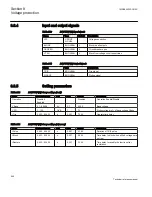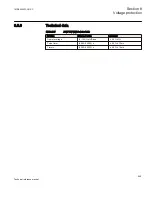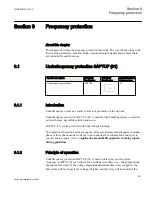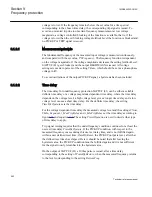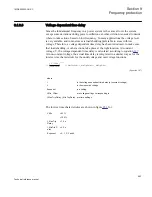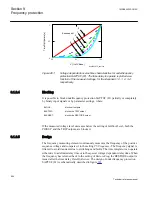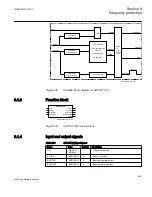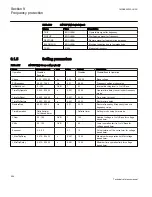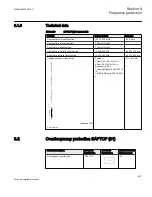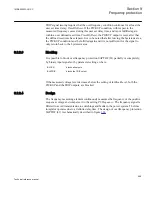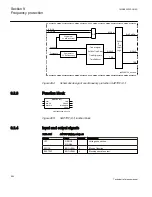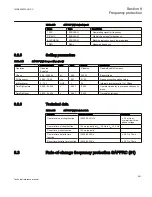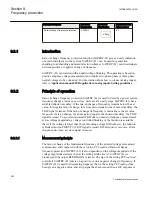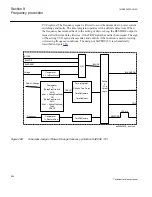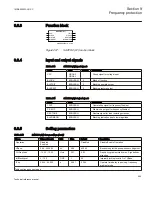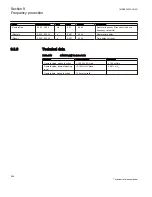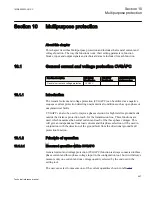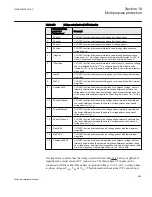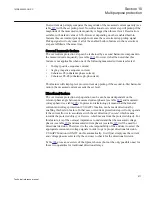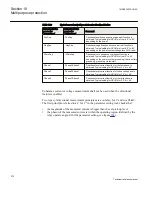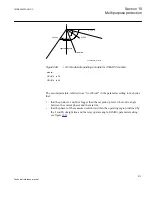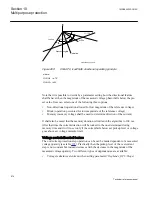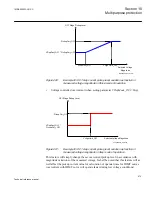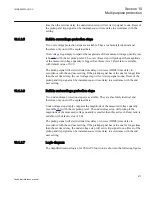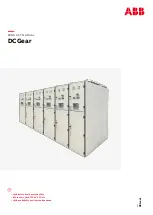
Function description
IEC 61850
identification
IEC 60617
identification
ANSI/IEEE C37.2
device number
Rate-of-change frequency protection
SAPFRC
df/dt
><
SYMBOL-N V1 EN
81
9.3.1
Introduction
Rate-of-change frequency protection function (SAPFRC,81) gives an early indication
of a main disturbance in the system. SAPFRC (81) can be used for generation
shedding, load shedding and remedial action schemes. SAPFRC (81) can discriminate
between positive or negative change of frequency.
SAPFRC (81) is provided with an undervoltage blocking. The operation is based on
positive sequence voltage measurement and requires two phase-phase or three phase-
neutral voltages to be connected. For information about how to connect analog inputs,
refer to
Application manual/IED application/Analog inputs/Setting guidelines
.
9.3.2
Principle of operation
Rate-of-change frequency protection SAPFRC (81) is used to detect fast power system
frequency changes, increase as well as, decrease at an early stage. SAPFRC (81) has a
settable definite time delay. If the rate-of-change of frequency remains below the set
value, for negative rate-of-change, for a time period equal to the chosen time delay, the
TRIP signal is issued. If the rate-of-change of frequency remains above the set value,
for positive rate-of-change, for a time period equal to the chosen time delay, the TRIP
signal is issued. To avoid an unwanted TRIP due to uncertain frequency measurement
at low voltage magnitude, a voltage controlled blocking of the function is available,
that is if the voltage is lower than the set blocking voltage
IntBlockLevel
, the function
is blocked and no PICKUP or TRIP signal is issued. If the frequency recovers, after a
frequency decrease, a restore signal is issued.
9.3.2.1
Measurement principle
The rate-of-change of the fundamental frequency of the selected voltage is measured
continuously, and compared with the set value,
PUFreqGrad
. Rate-of-change
frequency protection SAPFRC (81) is also dependent on the voltage magnitude. If the
voltage magnitude decreases below the setting
IntBlockLevel
, SAPFRC (81) is
blocked, and the output BLKDMAGN is issued. The sign of the setting
PUFreqGrad
,
controls if SAPFRC (81) reacts on a positive or on a negative change in frequency. If
SAPFRC (81) is used for decreasing frequency that is, the setting
PUFreqGrad
has
been given a negative value, and a trip signal has been issued, then a 100 ms pulse is
Section 9
1MRK505222-UUS C
Frequency protection
562
Technical reference manual
Summary of Contents for Relion 670 series
Page 1: ...Relion 670 series Line differential protection RED670 ANSI Technical reference manual...
Page 2: ......
Page 40: ...34...
Page 50: ...44...
Page 60: ...54...
Page 126: ...120...
Page 384: ...378...
Page 496: ...490...
Page 556: ...550...
Page 602: ...596...
Page 620: ...614...
Page 794: ...788...
Page 864: ...858...
Page 988: ...982...
Page 998: ...992...
Page 1084: ...1078...
Page 1164: ...1158...
Page 1168: ...1162...
Page 1220: ...1214...
Page 1230: ...1224...
Page 1231: ...1225...

